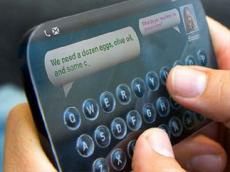|
|
TODAY.AZ / Weird / Interesting
Future of phone-touchscreen – PHOTOS
08 June 2012 [10:09] - TODAY.AZ
 Anyone who's struggled with fingers skating over today's touchscreens may be in for a relief - future generations of phones and tablets could offer real, transparent buttons that pop up out of the screen on demand.
Anyone who's struggled with fingers skating over today's touchscreens may be in for a relief - future generations of phones and tablets could offer real, transparent buttons that pop up out of the screen on demand. Californian start-up Tactus has developed a sheet of transparent buttons that rise up out of a touchscreen and disappear.
The company claims that the sheet only takes up the same amount of room as the layer of transparent glass in current touchscreens.
The technology could be used in tablets, phones and remote controls - and could even allow for touchscreens that can be played with the same precision that people use musical instruments.
Tactus describes its technology as a 'world first' that aims to address the shortcomings of touchscreen control.
'What if buttons could morph out of the surface of your device?,' says the company.
'Tactus provides a new dimension to touchscreens by enabling real, physical buttons that rise up from the surface on demand, and then recede back into the screen, leaving a perfectly flat, transparent surface when gone.'
Modern touchscreens are built of different ultra-thin layers of material - and Tactus claims that its Tactile Layer is as thin as the 'cover glass' currently used, and would require no change to the screens or sensors underneath.
With the buttons enabled, users can push and type or rest their fingers as they would with any physical button or keyboard.
When the buttons are disabled, they recede into the screen, becoming invisible and leaving a smooth, seamless flat touch-screen with maximum viewing area.
The technology could be used in tablets, phones and remote controls - and could even allow for touchscreens that can be played with the same precision that people use musical instruments
Tactus claims that its technology is a natural 'step beyond' the current vibration-based feedback - known as 'haptics' - used in touchscreens.
It also claims that it allows users to use touchscreens more precisely, knowing by touch where the buttons are.
'This is not a trick of your senses using vibration or stimulation, but rather real physical buttons that rise out of the surface of the screen,' says Tactus.
/dailymail.co.uk/
URL: http://www.today.az/news/interesting/108436.html
 Print version
Print version
Views: 2919
Connect with us. Get latest news and updates.
See Also
- 19 February 2025 [22:20]
Visa and Mastercard can return to Russia, but with restrictions - 05 February 2025 [19:41]
Japan plans to negotiate with Trump to increase LNG imports from United States - 23 January 2025 [23:20]
Dubai once again named cleanest city in the world - 06 December 2024 [22:20]
Are scented candles harmful to health? - 23 November 2024 [14:11]
Magnitude 4.5 earthquake hits Azerbaijan's Lachin - 20 November 2024 [23:30]
Launch vehicle with prototype of Starship made its sixth test flight - 27 October 2024 [09:00]
Fuel prices expected to rise in Sweden - 24 October 2024 [19:14]
Turkiye strikes terror targets in Iraq and Syria - 23 October 2024 [23:46]
Kazakhstan supplied almost entire volume of oil planned for 2024 to Germany in 9 months - 23 October 2024 [22:17]
Taiwan reported passage of Chinese Navy aircraft carrier near island
Most Popular
 How world "helps" conflict resolution
How world "helps" conflict resolution
 Documents reveal civilian attacks during April 2016 Battles at Baku court
Documents reveal civilian attacks during April 2016 Battles at Baku court
 bp commits massive funding to Gulf region operations
bp commits massive funding to Gulf region operations
 First VP Mehriban Aliyeva shares post on passing of Honored Artist Jabir Imanov
First VP Mehriban Aliyeva shares post on passing of Honored Artist Jabir Imanov
 Prime Minister Asadov arrives in Minsk for CIS government meeting
Prime Minister Asadov arrives in Minsk for CIS government meeting
 Saudi Arabia selected for Kia’s PV5 pilot program
Saudi Arabia selected for Kia’s PV5 pilot program
 New unified Cargo Processing Center opens at Baku International Sea Trade Port
New unified Cargo Processing Center opens at Baku International Sea Trade Port



